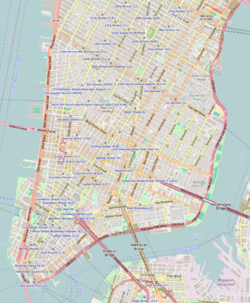University Settlement House
|
University Settlement Society of New York
|
|

University Settlement Society of New York
|
|
| Location | 184 Eldridge Street Manhattan New York City |
|---|---|
| Coordinates | 40°43′14″N 73°59′27″W / 40.72056°N 73.99083°WCoordinates: 40°43′14″N 73°59′27″W / 40.72056°N 73.99083°W |
| Architect | Howells & Stokes |
| Architectural style | Classical Revival |
| NRHP Reference # | |
| Added to NRHP | September 11, 1986 |
The University Settlement Society of New York is an American organization which provides educational and social services to immigrants and low-income families, located at 184 Eldridge Street (corner of Eldridge and Rivington Streets) on the Lower East Side of the Manhattan borough of New York City, New York. It provides numerous services for the mostly immigrant population of the neighborhood and has since 1886, when it was established as the first settlement house in the United States.
University Settlement was founded by Stanton Coit and Charles Bunstein Stover in 1886 as The Neighborhood Guild, in a basement on Forsyth Street.
Historically the settlement house, much like other settlement houses like Hull House (in Chicago, Illinois) and the Henry Street Settlement (also on the Lower East Side), served as a homes for hundreds of thousands of immigrants who arrived in the United States in the late-19th and early-20th century. They provided courses for new immigrants on everything from politics to the English language to basketball. The University Settlement House also included a library, kindergarten and the first public baths. These settlements were also loci of Progressive Era reform.
When founded, the resident workers at the University Settlement were all male and recent graduates of colleges. Several of these men were writers in addition to settlement house workers and used their writing as social protest and a means of reform. Residents between 1900 and 1907 included socialist writer William English Walling, a founder of the National Association for the Advancement of Colored People; Pulitzer Prize-winner Ernest Poole; Howard Brubaker, who later became a columnist for The New Yorker; writer Arthur Bullard; journalist Hamilton Holt; and author Walter Weyl, a founding editor of The New Republic. Their interest in reform led to several articles and books on the housing and employment situation of workers on the Lower East Side, particularly women and children.
...
Wikipedia





